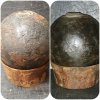Dug around 2 years ago, bathed in fresh and regularly changed, the wooden Boxer fuse soaked in PEG fluid and freeze dried.
EOD had it first and got rid of the black powder inside and returned it to me, it weighed in at 17lb with the black powder in it, unlike the solid shot which is 24lb...same dimensions though. Its marked with a P on the side which is perhaps a proof stamp from the IOA?
A bit of a beast and nice rivet on the base to connect to the wooden sabot which would have held it.





EOD had it first and got rid of the black powder inside and returned it to me, it weighed in at 17lb with the black powder in it, unlike the solid shot which is 24lb...same dimensions though. Its marked with a P on the side which is perhaps a proof stamp from the IOA?
A bit of a beast and nice rivet on the base to connect to the wooden sabot which would have held it.
































